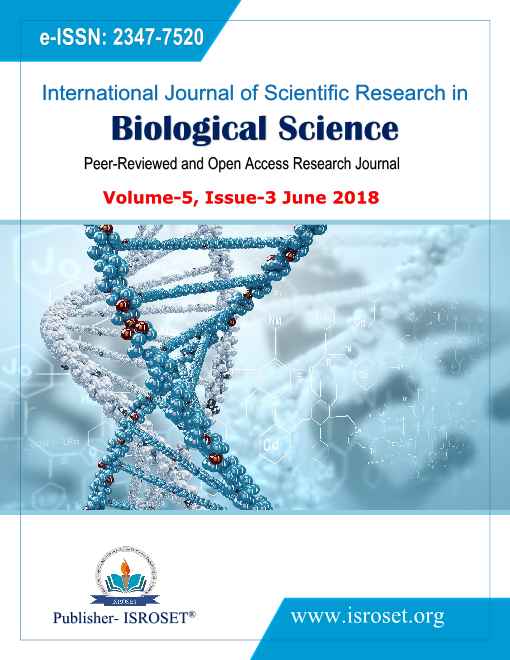Emerging fungal contaminants isolated and identified from raw fennel seeds
Keywords:
Fungal contaminants, Fennel seeds, Pathanamthitta, PDA medium, Colonization frequency, AspergillosisAbstract
The present investigation entitled “Emerging fungal contaminants isolated and identified from raw fennel seeds” recorded the diversity of surface contaminant fungi from 144 fennel seeds of different A/C and non-A/C hotels of town area of Pathanamthitta district of Kerala, which were cultured on PDA medium. All fungal species were identified on the basis of their morphological and microscopic characteristics and it includes Aspergillus niger, Aspergillus fumigatus, Chrysonilia sitophila, Mucor sp., Rhizopus sp., Cercospora sp. and Cylindrocarpon sp. The study revealed its colonization frequency, counted the fungal colony numbers, determined the percentage of different fungal isolates and finally compared the A/C and non-A/C seed contaminants. And from the study, it was clear that samples from non-A/C hotels shows maximum fungal growth than A/C hotels. These emerging fungal contaminants can cause serious pathogenic conditions such as aspergillosis, zygomycosis, occupational asthma etc.
References
K. Suvarna, S. Nandini, “Effect of Indigenous foods on blood glucose level of Type-2 diabetc patients”, International Journal Of Scientfic Resarch In Biological Science, Volume.2, Issue.5, pp.1, 2015.
E.A. Weiss, “Spice Crops”, CABI, Wallingford, pp.356-360, 2002
P. Anand, A. Kunnumkara, C. Sundaram, K. Harikumar, S. Tharakan , O. Lai, B. Sung, B. Aggarwal, “Cancer is a preventable disease that requires major lifestyle changes”, Pharm. Res., 25, pp. 2097-116, 2008.
J. Yu, Whitelaw, W.C. Nierman, D. Bhatnagar, T. E Cleveland, “Aspergillus flavus expressed sequence tags for identification of genes with putative roles in aflatoxin contamination of crops”. FEMS Microbiol. Lett. 237, pp. 333-340, 2004.
B. Romagnoli, V. Menna, N. Gruppioni, C. Bergamini, “Aflatoxins in spices, aromatic herbs, herbs-Teas and medicinal plants marketed in Italy”, pp. 697-701, 2007.
G. Dimic, S. Krinjar, M.V. Dosen-Bogic Evic, “Dance, a potential producer and sterigmatocystin in spices”, Tehnol. Mes. 41(4-6): pp. 131-137, 2000.
S.D. Kocic-Tanackov, G.R. Dimic, D. Karalic, “Contamination of spices with moulds potential producers of sterigmatocystine”. APTEFF, 38: pp. 29-35, 2007.
Z. I. El-Gali, “Detection of fungi associated with some spices in original form”, Glob.J.Sci.Res. 2(3): pp.83-88, 2014.
K.M. Mathew,“An excursion flora of central Tamilnadu,India”, Oxford and IBH Publishing, pp. 225 ,1991.
F.P Downes, K. Ito, “Compendium of Methods for the microbiological examination of foods”, 4th Ed., APHA, Washington,D.C, 2001.
Watanabe, Tsuneo, “Pictorial atlas of soil and seed fungi, Morphologies of cultured fungi and key to species”, 2nd edition, CRC Press, Washington D.C, pp. 121-125, 2002.
T.S. Suryanarayanan, G. Venkatesan, T.S Murali, “Endophytic fungal communities in the leaves of tropical forest trees: Diversity and distribution pattern”, Current sciences, 85(4): pp.489-492, 2003.
O.O. Atanda, I. Akpan, F. Oluwafemi, “The potential of some spice essential oils in the control of A. parasiticus CFR 223 and aflatoxin production”, pp.1-7, 2006.
M.C.Fischer, “Emerging fungal threats to animal, plant and ecosystem health”. Nature 484, 186-94, doi: 10.1038/nature 10947, 2012.
Downloads
Published
How to Cite
Issue
Section
License

This work is licensed under a Creative Commons Attribution 4.0 International License.
Authors contributing to this journal agree to publish their articles under the Creative Commons Attribution 4.0 International License, allowing third parties to share their work (copy, distribute, transmit) and to adapt it, under the condition that the authors are given credit and that in the event of reuse or distribution, the terms of this license are made clear.







